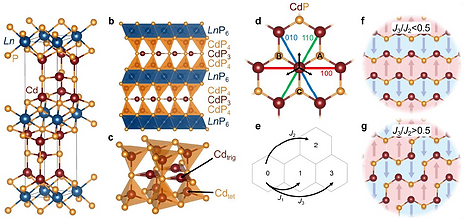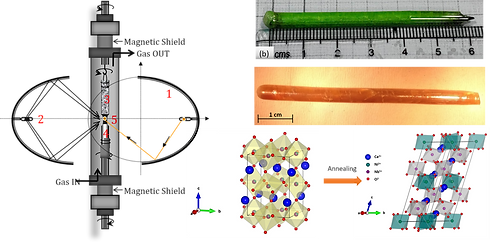Projects
Interleaved bond frustration in the triangular lattice antiferromagnet LnCd3P3
Frustration of long-range order via lattice geometries serves to amplify fluctuations of the order parameter and generate unconventional ground states that are highly sensitive to perturbations. Traditionally, this concept of geometric frustration is used to engineer unconventional magnetic states in a variety of materials; however, the charge degree of freedom and bond order can be similarly frustrated. Finding materials that host both frustrated magnetic and bond networks holds promise for engineering structural and magnetic states with the potential of coupling to one another via either the magnetic sector (via magnetic field) or via the lattice sector (via strain). In this paper, we identify an unusual instance of this coexistence in the triangular lattice antiferromagnetic compounds LnCd3P3 (Ln = La, Ce, Pr, and Nd). These compounds feature two-dimensional planes of unique trigonal-planar CdP3 units that manifest an underlying bond instability with its long-range ordering frustrated via emergent kagome ice bond correlations. Our results establish LnCd3P3 as a rare class of materials where frustrated magnetism across a tunable rare-earth triangular network is embedded within a dopable semiconductor with a frustrated bond order instability.



Structural and physical properties of trilayer nickelates R4Ni3O10 (R = La, Pr, and Nd)
Ruddlesden Popper nickelates with the general formula - Rn+1NinO3n+1 (R = La, Pr and Nd) have garnered immense attention due to their structural and electronic similarity to high Tc superconducting cuprates. We have carried out a detailed low-temperature structural analysis of the R4Ni3O10 (R = La, Pr and Nd) compounds and have successfully captured the metal-to-metal transition (MMT) in low-temperature synchrotron PXRD, resistivity, specific heat, magnetic susceptibility, thermopower, thermal conductivity and zero field capacitive dilatometry experiments. These compounds showcase a strong coupling between the electronic, magnetic and structural degrees of freedom.
Systematic evolution of the ground state from a correlated metal to that of a charge/spin stripe insulator in the trilayer nickelate series

Recently there has been an enormous uproar in the condensed matter community regarding the discovery of superconductivity in thin films of hole-doped layered nickelates, i.e., the R1-xSrxNiO2 (R = La, Pr and Nd) family. Layered nickelates have the potential for exotic physics as they have an electronic and crystal structure analogous to HTSC cuprates. In this vein, the mixed valent T' nickelates with the general formula Rn+1NinO2n+2 provide an ideal test bed to explore this conjecture. In this project, I try to understand the origin of the semiconductor-to-insulator transition associated with La4Ni3O8. This transition is associated with concomitant charge/spin stripe ordering. By doping La at Pr site, we try to induce the ground state of La438 in Pr438 and keenly observe the underlying mechanism related to the crossover.
Single crystal growth and low temperature properties of the triangular lattice AFM - Ca3NiNb2O9
We could successfully grow large, high-quality single crystals of the triple perovskite - Ca3NiNb2O9 (CNNO) and its non-magnetic analogue - Ca3MgNb2O9 (CMNO) using the four-mirror optical float zone furnace. We discovered that the ground state properties of CNNO are highly sensitive to the growth conditions and post-growth annealing treatments. We also carried out single crystal neutron diffraction at the D10 beamline of ILL, France, to shed light on this compound's magnetic structure.

